On 6 November 2017, German leading lady Karin Dor (1938-2017) has passed away. The redheaded actress became popular in the 1960s playing heroines in Edgar Wallace and Karl May films. She was Winnetou’s greatest love but also the first German Bond girl. After appearing in more international films, including one by Alfred Hitchcock, she became a respected stage actress in Germany. Karin Dor was 79.
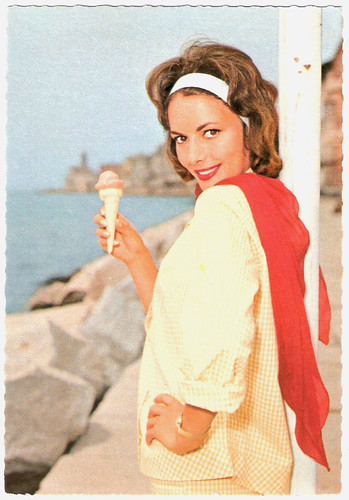
German postcard by ISV.
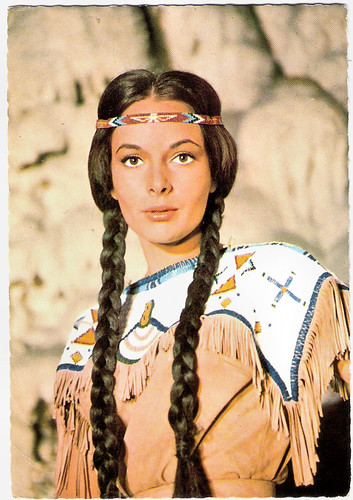
German postcard, no. R 30. Photo: publicity still for Winnetou 2. Teil/Winnetou: The Red Gentleman (Harald Reinl, 1964). Caption: Der Friede ist gerettet. Ribanna weiss, dass ihr und Winnetous Opfer nicht umsonst war. (Peace is saved. Ribanna knows that her and Winnetou's sacrifice was not in vain.)
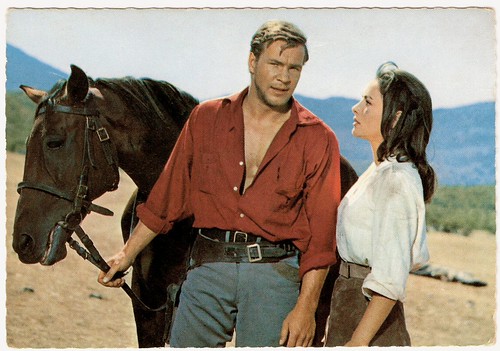
German postcard, no. ED 65. Photo: Constantin. Still from Der Schatz in Silbersee (1962, Harald Reinl) with Götz George.
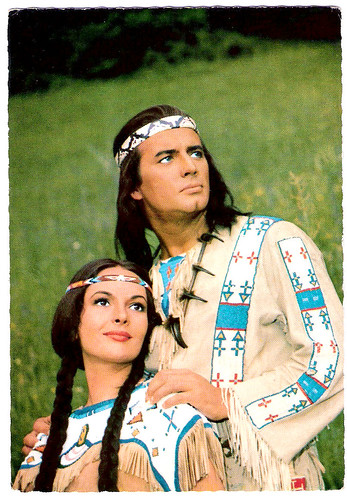
German postcard, no. R 17. Photo: publicity still for Winnetou 2. Teil/Winnetou: The Red Gentleman (Harald Reinl, 1964) with Pierre Brice. Caption: So werden Ribanna und Winnetou gezwungen, ihre Liebe dem Frieden zu opfern. (Thus Ribanna and Winnetou are forced to sacrifice their love.)
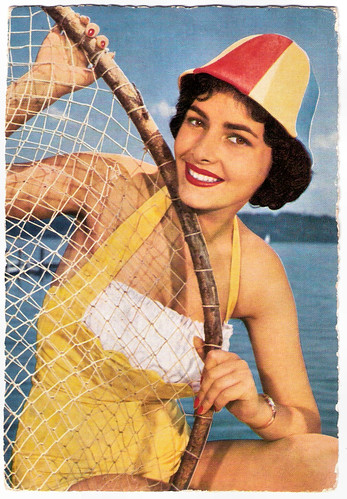
German postcard by WS-Druck, Wanne-Eickel, no. F 31. Photo: Klaus Collignon.
Karin Dor was born as Kätherose Derr in Wiesbaden, Germany in 1938. She grew up in a middle-class family. Although she initially wanted to become a fashion designer, she took actor's training and ballet lessons.
At 17, she tried to break into the film industry, starting as an extra in Der letzte Walzer/The Last Waltz (Arthur Maria Rabenalt, 1953). Her director, Arthur Maria Rabenalt recommended her to his upcoming colleague Harald Reinl who gave her small speaking parts in his films Rosen-Resli/Rose-Girl Resli (Harald Reinl, 1954) and Der schweigende Engel/The Silent Angel (Harald Reinl, 1954), both starring Christine Kaufmann.
That same year, Dor married her Austrian director, who was 30 years her elder. She pretended to be two years older (several sources, including the normally well-informed French site Les Gens du Cinéma, still give 1936 as her birth date) to marry without problems.
The young actress made her first major appearances as a high-school graduate in Ihre grosse Prüfung/The Big Test (Rudolf Jugert, 1955) with Luise Ullrich, and as a mayor's daughter during the Spanish Civil War in the melodrama Solange du lebst/As Long As You Live (Harald Reinl, 1955) with Adrian Hoven. Hal Erickson writes at AllMovie that “though the leading lady of this film, Marianne Koch, received several awards for her performance, many male viewers were more interested in her sexier costar Karin Dor”.
A curiosity was the comedy Mit Eva fing die Sünde an/Bellboy and the Playgirls (Fritz Umgelter, 1958), which centres on a bellhop who prepares for his dream job of becoming a detective by spying on half-naked chorines through a keyhole. Just before the film was distributed in the US in 1962, the young Francis Ford Coppola was hired to add additional scenes featuring nude women - shot in 3-D - to spice up the story.

German postcard by Kolibri-Verlag G.m.b.H., Minden/Westf., no. 1014. Photo: Zeyn / Union-Film / Spörr.
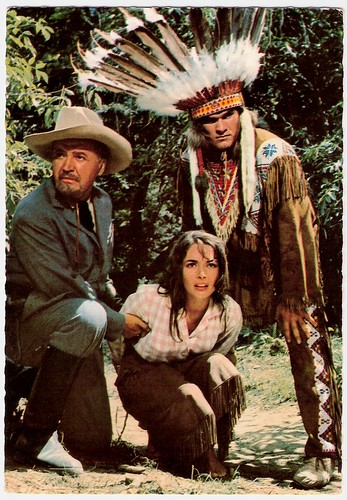
German postcard, no. E 80. Photo: Constantin. Publicity still for Der Schatz im Silbersee/The Treasure of Silver Lake (Harald Reinl, 1962) with Karin Dor and Jan Sid.

German postcard, no. E 76. Photo: Constantin. Publicity still for Der Schatz im Silbersee/The Treasure of Silver Lake (Harald Reinl, 1962) with Götz George and Karin Dor.

German postcard by Rüdel-Verlag. Photo: Rialto / Constantin / Vogelmann. Publicity still for Der Schatz im Silbersee/The Treasure of Silver Lake (Harald Reinl, 1962).
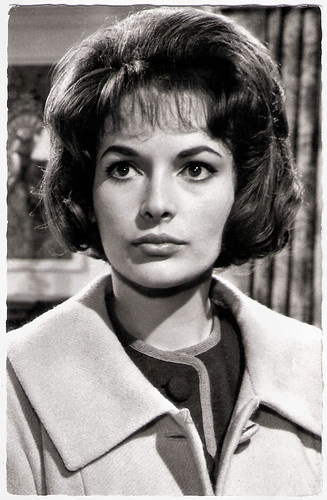
German postcard.
According to Filmportal.de, Karin Dor specialised in gentle and naive roles in popular music films and sentimental comedies with a regional background.
However she managed to successfully transfer her image to the crime film genre in Die Bande des Schreckens/Hand of the Gallows (Harald Reinl, 1960), the third film in the Edgar Wallace series. Dor became popular as ‘Miss Krimi’ and was seen in eleven Wallace films.
She also appeared in the Dr. Mabuse and Fu Manchu horror melodrama series: in Die Unsichtbaren Krallen des Dr. Mabuse/The Invisible Dr. Mabuse (Harald Reinl, 1962) and Ich, Dr. Fu Man Chu/The Face of Fu Manchu (Don Sharp, 1962) starring Christopher Lee.
Karin Dor often played the innocent damsel in distress, who opposed the bad guys bravely till the hero saved her. In that role, she also became a key asset to the Karl May film series, the second huge West-German genre success. First, she appeared in Der Schatz im Silbersee/The Treasure of Silver Lake (Harald Reinl, 1962), the first film with Lex Barker as Old Shatterhand and Pierre Brice as Winnetou. In Winnetou 2. Teil/Last of the Renegades (Harald Reinl, 1964), she was Ribanna, Winnetou’s greatest love.
She also appeared in the Eurowesterns Der letzte Mohikaner/The Last of the Mohicans (Harald Reinl, 1965), Winnetou - 3. Teil/The Desperado Trail (Harald Reinl, 1965) and Winnetou und Shatterhand im Tal der Toten/In the Valley of Death (Harald Reinl, 1968). For these roles, she was awarded the Scharlih-Prize in 1994, the best-known award connected to Karl May.
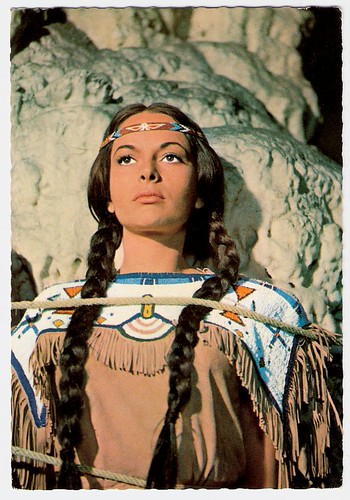
German postcard, no. R 6. Photo: still from Winnetou - 2. Teil/Last of the Renegades (Harald Reinl, 1964) with Karin Dor as Ribanna.

German postcard, no. R 7. Photo: still from Winnetou - 2. Teil/Last of the Renegades (Harald Reinl, 1964) with Karin Dor as Ribanna and Pierre Brice as Winnetou.

German postcard, no. R 19. Photo: still from Winnetou - 2. Teil/Last of the Renegades (Harald Reinl, 1964) with Karin Dor as Ribanna.
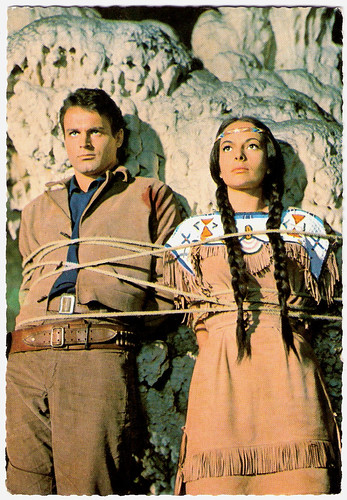
German postcard, no. R 22. Photo: publicity still for Winnetou - 2. Teil/Last of the Renegades (Harald Reinl, 1964) with Mario Girotti and Karin Dor. Caption: Auch Ribanna und ihr Mann Leutnant Merrill fallen in die Hände der Bande. Sie werden als Gefangene an einen Felsen gebunden. (Ribanna and her husband Lt. Merrill also fall into the hands of the gang. They are bound as prisoners to a rock.)
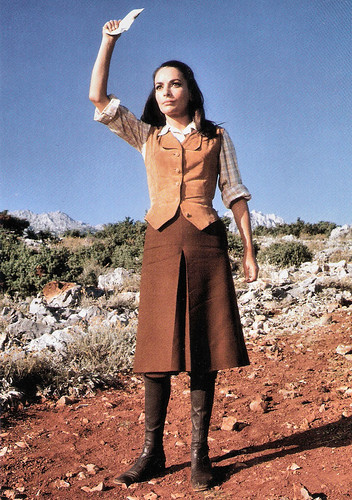
German postcard, no. 15 (1-36). Photo: CCC / Constantin. Publicity still for Winnetou und Shatterhand im Tal der Toten/The Valley of Death (Harald Reinl, 1968). Caption: Mabel will den Banditen den Brief übergeben, um Leutnant Cummings zu retten. (Mabel wants to give the letter to the bandits to save Lieutenant Cummings.)
A turning point in Karin Dor’s career was her great role as the demonic Brunhild in the two-part Burgundian saga Die Nibelungen/Those whom the Gods wish to destroy (Harald Reinl, 1966). Although the film was not well received by the critics, it became the start of Dor's international film career.
As Germany's ‘star without affairs’ Dor got the part of sexy agent Helga Brandt in the fifth James Bond opus, You Only Live Twice (Lewis Gilbert, 1967) alongside Sean Connery. It enabled her as ‘The first German Bond girl’ to act against her former, rather virtuous role image. She delivered a convincing performance as a red-haired temptress trying to stop the famous undercover agent using her erotic charm.
In 1968, Karin Dor became sick with cancer and she also divorced Harald Reinl. There was a brief halt in her career.
Suddenly she got the unexpected offer to play a Cuban woman in Alfred Hitchcock's spy thriller Topaz (1969). Dor starred as the beautiful and proud Juanita de Cordoba, the leader of an underground movement. She and her lover collaborate with the West.
Her death scenes in both aforementioned films were spectacular. In the Bond film, Helga Brandt is devoured by piranhas; and in Topaz Juanita is shot by her jealous lover (John Vernon), in the style of an opera's finale.
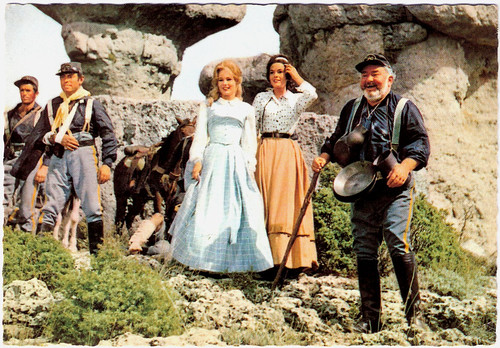
German postcard, no. 35 of 64. Photo: Constantin. Still from Der Lezte Mohikaner/The Last of the Mohicans (Harald Reinl, 1965) with Karin Dor, Marie France and Kurt Grosskurth. Caption: Der Koch hat die kleine Gruppe zum 'Garten der Steinerne Bäume' geführt. Welch ein Freude, als nun auch Captain Hayward unversehrt auftaucht und bald darauf Unkas und Falkenauge mit den Pferden. Nun kann man zu Munroes Farm aufbrechen! (The chef has led the small group to the 'Garden of Stone Trees'. What a joy when Captain Hayward emerges intact and soon after Uncas and Hawk Eye with the horses. Now they can leave for Munroe's Farm !)

German postcard, no. 39 of 64. Photo: Constantin. Still from Der Lezte Mohikaner/The Last of the Mohicans (Harald Reinl, 1965) with Daniel Martin, Anthony Steffen and Karin Dor. Caption: Kurz von der Munroe-Farm, im Schutze der Felsen, macht die kleine Gruppe halt. Sie überzeugt sich davon, dass die Farm von Rogers bande und den Irokesen umzingelt ist. Wie sollen sie nun hinein gelangen? Wiederum verfällt man auf eine Liste. Wie früher der Oberst, wenn er nach Hause zurück kehrte, mit einem Roten Tuch winkte, genauso soll sich Unkas der Farm nähern, damit man seine friedlichen Absichten erkennt. Cora bindet Unkas ihr rotes Halstuch um den Arm. (Near the Munroe farm, in the shelter of the rocks, the small group makes halt. They convinced themselves that the farm of Rogers bande and the Iroquois is surrounded. But how can they get inside? Again, one falls on a list. As before the colonel, when he returned home, Unkas will wave a red cloth when he goes nearer to the farm, so that you can see his peaceful intentions. Cora binds her red scarf around Unkas arm.)
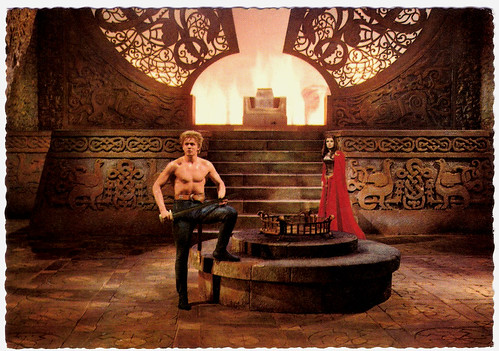
German postcard, no. 5. Photo: CCC / Constantin Film. Publicity still for Die Nibelungen, Teil 1 - Siegfried / Siegfried (Harald Reinl, 1966) with Uwe Beyer as Siegfried and Karin Dor as Brunhild.
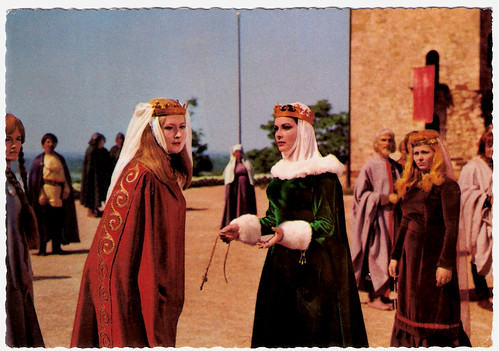
German postcard, no. 13. Photo: CCC / Constantin Film. Publicity still for Die Nibelungen, Teil 1 - Siegfried / Siegfried (Harald Reinl, 1967) with Maria Marlow as Kriemhild and Karin Dor as Brunhild. Caption: "Beim Kirchgang begegnen sich die Königinnen Kriemhild und Brunhild. Von Eifersucht geplagt, wirft Kriemhild der Königin von Burgund vor, dass nicht ihr Bruder Gunther, sondern Siegfried Brunhild besiegt hätte. Als Beweis zeigt sie Brunhild deren Zaubergürtel. Die Königinnen trennen sich in Zorn und Hass." (When going to the church, the queens Kriemhild and Brunhild encounter. From jealousy plagued Kriemhild tells the Queen of Burgundy that not her brother Gunther but Siegfried has defeated Brunhild . As proof, she points Brunhild the magic belt. The queens separate in anger and hatred.).
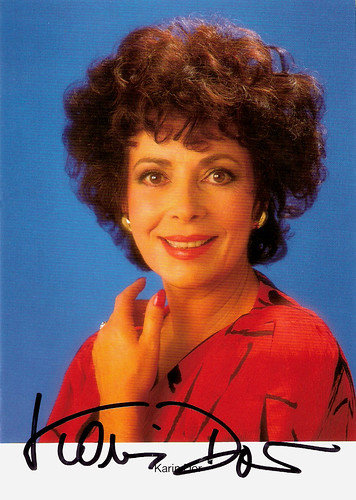
German postcard by Franz Josef Rüdel, Filmpostkartenverlag, Hamburg. Photo: Axel Strencioch.
Till the early 1970s, Karin Dor featured in more international films like the British pulp thriller Die Screaming, Marianne (Pete Walker, 1970) starring Susan George in her debut, Die Antwort kennt nur der Wind/Only the Wind Knows the Answer (Alfred Vohrer, 1974) with Maurice Ronet, and Warhead (John O'Connor, 1974-1976) with David Janssen.
She also guest-starred in TV series like It Takes a Thief (1969), Ironside (1970) and The F.B.I. (1970). When the film offers dried up, she decided to focus on the German stage. There she appeared in classics as 'Tartuffe', but also in boulevard comedies like 'Der Neurosenkavalier'. In the latter, she performed more than 500 times.
Her TV work in the 1990s included the family series Die große Freiheit/The Big Freedom (1990) where she starred alongside Hans-Joachim Kuhlenkampff as well as the TV film Der Preis der Liebe/The Price of Love (1998), a Rosamunde Pilcher adaptation.
She made a cinema comeback as Katja Riemann’s alcoholic mother in Ich bin die Andere/I Am the Other Woman (Margarethe von Trotta, 2006). In 2008 she was back on the Munich stage in the (non-Bond-related) comedy 'Man lebt nur dreimal' (You Only Live Three Times), which was especially written for her.
Karin Dor has a son from her first husband Harald Reinl, Andreas (1955). In 1972 she married merchant Günther Schmucker, but the pair divorced two years later. Her third husband was American stunt director George Robotham, to whom she was married from 1988 till his death in 2007. In 2015, she returned to the screen in Die abhandene Welt/The Misplaced World (Margaretha von Trotta, 2015) with Barbara Sukowa and Katja Riemann. On 6 November 2017, Karin Dor died in München (Munich), Germany. She was 79
Trailer for Der Fälscher von London/The Forger of London (1961). Source: Rialto Film (YouTube).
Trailer for You Only Live Twice (1967). Source: Movieclips Trailer Vault (YouTube).
Trailer Die screaming Marianne (1971). Source: The Susan George Channel (YouTube).
Trailer for Die abhandene Welt/The Misplaced World(2015). Source: Vipmagazin (YouTube).
Sources: Stephanie D’heil (Steffi-line - German), Hal Erickson (AllMovie), Filmportal.de, Les Gens du Cinéma (French), Wikipedia and IMDb
This post was last updated on 20 January 2024.

German postcard by ISV.

German postcard, no. R 30. Photo: publicity still for Winnetou 2. Teil/Winnetou: The Red Gentleman (Harald Reinl, 1964). Caption: Der Friede ist gerettet. Ribanna weiss, dass ihr und Winnetous Opfer nicht umsonst war. (Peace is saved. Ribanna knows that her and Winnetou's sacrifice was not in vain.)

German postcard, no. ED 65. Photo: Constantin. Still from Der Schatz in Silbersee (1962, Harald Reinl) with Götz George.

German postcard, no. R 17. Photo: publicity still for Winnetou 2. Teil/Winnetou: The Red Gentleman (Harald Reinl, 1964) with Pierre Brice. Caption: So werden Ribanna und Winnetou gezwungen, ihre Liebe dem Frieden zu opfern. (Thus Ribanna and Winnetou are forced to sacrifice their love.)

German postcard by WS-Druck, Wanne-Eickel, no. F 31. Photo: Klaus Collignon.
Harald Reinl
Karin Dor was born as Kätherose Derr in Wiesbaden, Germany in 1938. She grew up in a middle-class family. Although she initially wanted to become a fashion designer, she took actor's training and ballet lessons.
At 17, she tried to break into the film industry, starting as an extra in Der letzte Walzer/The Last Waltz (Arthur Maria Rabenalt, 1953). Her director, Arthur Maria Rabenalt recommended her to his upcoming colleague Harald Reinl who gave her small speaking parts in his films Rosen-Resli/Rose-Girl Resli (Harald Reinl, 1954) and Der schweigende Engel/The Silent Angel (Harald Reinl, 1954), both starring Christine Kaufmann.
That same year, Dor married her Austrian director, who was 30 years her elder. She pretended to be two years older (several sources, including the normally well-informed French site Les Gens du Cinéma, still give 1936 as her birth date) to marry without problems.
The young actress made her first major appearances as a high-school graduate in Ihre grosse Prüfung/The Big Test (Rudolf Jugert, 1955) with Luise Ullrich, and as a mayor's daughter during the Spanish Civil War in the melodrama Solange du lebst/As Long As You Live (Harald Reinl, 1955) with Adrian Hoven. Hal Erickson writes at AllMovie that “though the leading lady of this film, Marianne Koch, received several awards for her performance, many male viewers were more interested in her sexier costar Karin Dor”.
A curiosity was the comedy Mit Eva fing die Sünde an/Bellboy and the Playgirls (Fritz Umgelter, 1958), which centres on a bellhop who prepares for his dream job of becoming a detective by spying on half-naked chorines through a keyhole. Just before the film was distributed in the US in 1962, the young Francis Ford Coppola was hired to add additional scenes featuring nude women - shot in 3-D - to spice up the story.

German postcard by Kolibri-Verlag G.m.b.H., Minden/Westf., no. 1014. Photo: Zeyn / Union-Film / Spörr.

German postcard, no. E 80. Photo: Constantin. Publicity still for Der Schatz im Silbersee/The Treasure of Silver Lake (Harald Reinl, 1962) with Karin Dor and Jan Sid.

German postcard, no. E 76. Photo: Constantin. Publicity still for Der Schatz im Silbersee/The Treasure of Silver Lake (Harald Reinl, 1962) with Götz George and Karin Dor.

German postcard by Rüdel-Verlag. Photo: Rialto / Constantin / Vogelmann. Publicity still for Der Schatz im Silbersee/The Treasure of Silver Lake (Harald Reinl, 1962).

German postcard.
Miss Krimi
According to Filmportal.de, Karin Dor specialised in gentle and naive roles in popular music films and sentimental comedies with a regional background.
However she managed to successfully transfer her image to the crime film genre in Die Bande des Schreckens/Hand of the Gallows (Harald Reinl, 1960), the third film in the Edgar Wallace series. Dor became popular as ‘Miss Krimi’ and was seen in eleven Wallace films.
She also appeared in the Dr. Mabuse and Fu Manchu horror melodrama series: in Die Unsichtbaren Krallen des Dr. Mabuse/The Invisible Dr. Mabuse (Harald Reinl, 1962) and Ich, Dr. Fu Man Chu/The Face of Fu Manchu (Don Sharp, 1962) starring Christopher Lee.
Karin Dor often played the innocent damsel in distress, who opposed the bad guys bravely till the hero saved her. In that role, she also became a key asset to the Karl May film series, the second huge West-German genre success. First, she appeared in Der Schatz im Silbersee/The Treasure of Silver Lake (Harald Reinl, 1962), the first film with Lex Barker as Old Shatterhand and Pierre Brice as Winnetou. In Winnetou 2. Teil/Last of the Renegades (Harald Reinl, 1964), she was Ribanna, Winnetou’s greatest love.
She also appeared in the Eurowesterns Der letzte Mohikaner/The Last of the Mohicans (Harald Reinl, 1965), Winnetou - 3. Teil/The Desperado Trail (Harald Reinl, 1965) and Winnetou und Shatterhand im Tal der Toten/In the Valley of Death (Harald Reinl, 1968). For these roles, she was awarded the Scharlih-Prize in 1994, the best-known award connected to Karl May.

German postcard, no. R 6. Photo: still from Winnetou - 2. Teil/Last of the Renegades (Harald Reinl, 1964) with Karin Dor as Ribanna.

German postcard, no. R 7. Photo: still from Winnetou - 2. Teil/Last of the Renegades (Harald Reinl, 1964) with Karin Dor as Ribanna and Pierre Brice as Winnetou.

German postcard, no. R 19. Photo: still from Winnetou - 2. Teil/Last of the Renegades (Harald Reinl, 1964) with Karin Dor as Ribanna.

German postcard, no. R 22. Photo: publicity still for Winnetou - 2. Teil/Last of the Renegades (Harald Reinl, 1964) with Mario Girotti and Karin Dor. Caption: Auch Ribanna und ihr Mann Leutnant Merrill fallen in die Hände der Bande. Sie werden als Gefangene an einen Felsen gebunden. (Ribanna and her husband Lt. Merrill also fall into the hands of the gang. They are bound as prisoners to a rock.)

German postcard, no. 15 (1-36). Photo: CCC / Constantin. Publicity still for Winnetou und Shatterhand im Tal der Toten/The Valley of Death (Harald Reinl, 1968). Caption: Mabel will den Banditen den Brief übergeben, um Leutnant Cummings zu retten. (Mabel wants to give the letter to the bandits to save Lieutenant Cummings.)
James Bond
A turning point in Karin Dor’s career was her great role as the demonic Brunhild in the two-part Burgundian saga Die Nibelungen/Those whom the Gods wish to destroy (Harald Reinl, 1966). Although the film was not well received by the critics, it became the start of Dor's international film career.
As Germany's ‘star without affairs’ Dor got the part of sexy agent Helga Brandt in the fifth James Bond opus, You Only Live Twice (Lewis Gilbert, 1967) alongside Sean Connery. It enabled her as ‘The first German Bond girl’ to act against her former, rather virtuous role image. She delivered a convincing performance as a red-haired temptress trying to stop the famous undercover agent using her erotic charm.
In 1968, Karin Dor became sick with cancer and she also divorced Harald Reinl. There was a brief halt in her career.
Suddenly she got the unexpected offer to play a Cuban woman in Alfred Hitchcock's spy thriller Topaz (1969). Dor starred as the beautiful and proud Juanita de Cordoba, the leader of an underground movement. She and her lover collaborate with the West.
Her death scenes in both aforementioned films were spectacular. In the Bond film, Helga Brandt is devoured by piranhas; and in Topaz Juanita is shot by her jealous lover (John Vernon), in the style of an opera's finale.

German postcard, no. 35 of 64. Photo: Constantin. Still from Der Lezte Mohikaner/The Last of the Mohicans (Harald Reinl, 1965) with Karin Dor, Marie France and Kurt Grosskurth. Caption: Der Koch hat die kleine Gruppe zum 'Garten der Steinerne Bäume' geführt. Welch ein Freude, als nun auch Captain Hayward unversehrt auftaucht und bald darauf Unkas und Falkenauge mit den Pferden. Nun kann man zu Munroes Farm aufbrechen! (The chef has led the small group to the 'Garden of Stone Trees'. What a joy when Captain Hayward emerges intact and soon after Uncas and Hawk Eye with the horses. Now they can leave for Munroe's Farm !)

German postcard, no. 39 of 64. Photo: Constantin. Still from Der Lezte Mohikaner/The Last of the Mohicans (Harald Reinl, 1965) with Daniel Martin, Anthony Steffen and Karin Dor. Caption: Kurz von der Munroe-Farm, im Schutze der Felsen, macht die kleine Gruppe halt. Sie überzeugt sich davon, dass die Farm von Rogers bande und den Irokesen umzingelt ist. Wie sollen sie nun hinein gelangen? Wiederum verfällt man auf eine Liste. Wie früher der Oberst, wenn er nach Hause zurück kehrte, mit einem Roten Tuch winkte, genauso soll sich Unkas der Farm nähern, damit man seine friedlichen Absichten erkennt. Cora bindet Unkas ihr rotes Halstuch um den Arm. (Near the Munroe farm, in the shelter of the rocks, the small group makes halt. They convinced themselves that the farm of Rogers bande and the Iroquois is surrounded. But how can they get inside? Again, one falls on a list. As before the colonel, when he returned home, Unkas will wave a red cloth when he goes nearer to the farm, so that you can see his peaceful intentions. Cora binds her red scarf around Unkas arm.)

German postcard, no. 5. Photo: CCC / Constantin Film. Publicity still for Die Nibelungen, Teil 1 - Siegfried / Siegfried (Harald Reinl, 1966) with Uwe Beyer as Siegfried and Karin Dor as Brunhild.

German postcard, no. 13. Photo: CCC / Constantin Film. Publicity still for Die Nibelungen, Teil 1 - Siegfried / Siegfried (Harald Reinl, 1967) with Maria Marlow as Kriemhild and Karin Dor as Brunhild. Caption: "Beim Kirchgang begegnen sich die Königinnen Kriemhild und Brunhild. Von Eifersucht geplagt, wirft Kriemhild der Königin von Burgund vor, dass nicht ihr Bruder Gunther, sondern Siegfried Brunhild besiegt hätte. Als Beweis zeigt sie Brunhild deren Zaubergürtel. Die Königinnen trennen sich in Zorn und Hass." (When going to the church, the queens Kriemhild and Brunhild encounter. From jealousy plagued Kriemhild tells the Queen of Burgundy that not her brother Gunther but Siegfried has defeated Brunhild . As proof, she points Brunhild the magic belt. The queens separate in anger and hatred.).

German postcard by Franz Josef Rüdel, Filmpostkartenverlag, Hamburg. Photo: Axel Strencioch.
You Only Live Three Times
Till the early 1970s, Karin Dor featured in more international films like the British pulp thriller Die Screaming, Marianne (Pete Walker, 1970) starring Susan George in her debut, Die Antwort kennt nur der Wind/Only the Wind Knows the Answer (Alfred Vohrer, 1974) with Maurice Ronet, and Warhead (John O'Connor, 1974-1976) with David Janssen.
She also guest-starred in TV series like It Takes a Thief (1969), Ironside (1970) and The F.B.I. (1970). When the film offers dried up, she decided to focus on the German stage. There she appeared in classics as 'Tartuffe', but also in boulevard comedies like 'Der Neurosenkavalier'. In the latter, she performed more than 500 times.
Her TV work in the 1990s included the family series Die große Freiheit/The Big Freedom (1990) where she starred alongside Hans-Joachim Kuhlenkampff as well as the TV film Der Preis der Liebe/The Price of Love (1998), a Rosamunde Pilcher adaptation.
She made a cinema comeback as Katja Riemann’s alcoholic mother in Ich bin die Andere/I Am the Other Woman (Margarethe von Trotta, 2006). In 2008 she was back on the Munich stage in the (non-Bond-related) comedy 'Man lebt nur dreimal' (You Only Live Three Times), which was especially written for her.
Karin Dor has a son from her first husband Harald Reinl, Andreas (1955). In 1972 she married merchant Günther Schmucker, but the pair divorced two years later. Her third husband was American stunt director George Robotham, to whom she was married from 1988 till his death in 2007. In 2015, she returned to the screen in Die abhandene Welt/The Misplaced World (Margaretha von Trotta, 2015) with Barbara Sukowa and Katja Riemann. On 6 November 2017, Karin Dor died in München (Munich), Germany. She was 79
Trailer for Der Fälscher von London/The Forger of London (1961). Source: Rialto Film (YouTube).
Trailer for You Only Live Twice (1967). Source: Movieclips Trailer Vault (YouTube).
Trailer Die screaming Marianne (1971). Source: The Susan George Channel (YouTube).
Trailer for Die abhandene Welt/The Misplaced World(2015). Source: Vipmagazin (YouTube).
Sources: Stephanie D’heil (Steffi-line - German), Hal Erickson (AllMovie), Filmportal.de, Les Gens du Cinéma (French), Wikipedia and IMDb
This post was last updated on 20 January 2024.
1 comment:
She was such a beauty, really.
Great tribute as always.
Post a Comment